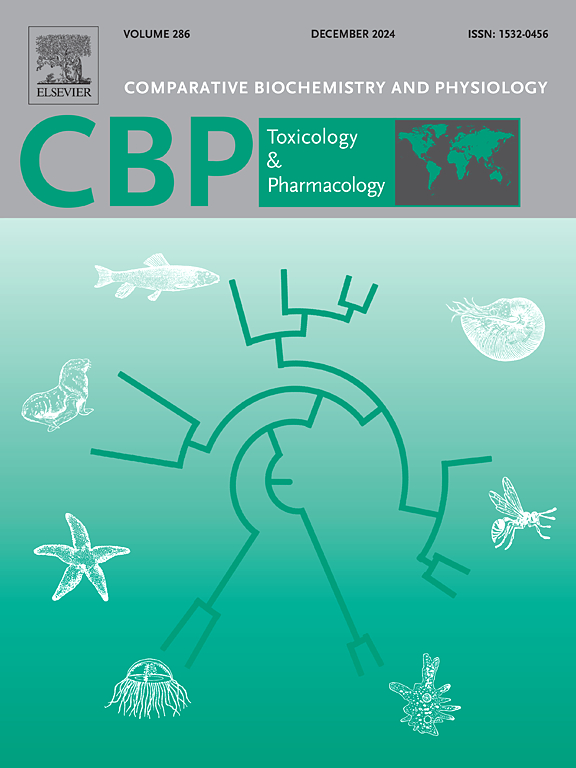EGCG attenuates BPA -induced male reproductive toxicity by regulating the blood-testis barrier by suppressing autophagy via AMPK/AKT/mTOR signaling pathway
IF 4.3
3区 环境科学与生态学
Q2 BIOCHEMISTRY & MOLECULAR BIOLOGY
Comparative Biochemistry and Physiology C-toxicology & Pharmacology
Pub Date : 2025-07-22
DOI:10.1016/j.cbpc.2025.110298
引用次数: 0
Abstract
Bisphenol A (BPA) is a typical endocrine disrupting chemical widely distributed in the environment and in food systems. The adverse effects of BPA on reproductive health have posed major concerns worldwide. The aim of this study was to determine the potential of epigallocatechin gallate (EGCG) to protect against BPA-induced male reproductive toxicity and investigate the underlying protective mechanism. The protective effects of EGCG on BPA-induced reproductive toxicity were investigated using male zebrafish model. The results showed that EGCG alleviated BPA-induced developmental toxicity of F1 generation of zebrafish, reversed testis disorder and combated the blood-testis barrier (BTB) damage caused by BPA in zebrafish. In order to unravel the underlying mechanism, TM4 cell - constructed BTB model was used for further study. The results indicated that EGCG counteracted the damage induced by BPA on the integrity of BTB model and reduced the autophagy caused by BPA. Furthermore, EGCG effectively inhibited the BPA-induced upregulation of the expression level of AMPK (p-AMPKα/AMPKα), significantly restored the BPA-mediated downregulation of the expression levels of p-mTOR/mTOR, p-AKT/AKT and Raptor. The results suggested that EGCG mitigated the BPA-induced male reproductive toxicity through maintaining the integrity of BTB by inhibiting the autophagy mediated by AMPK/AKT/mTOR signaling pathway. This study provided a strategy for combating the BPA-induced reproductive toxicity using a well-known bioactive component as a potential therapeutic approach.

EGCG通过AMPK/AKT/mTOR信号通路抑制自噬,调节血睾丸屏障,从而减弱BPA诱导的雄性生殖毒性。
双酚A (BPA)是一种典型的内分泌干扰物质,广泛存在于环境和食品系统中。双酚a对生殖健康的不利影响已引起全世界的关注。本研究的目的是确定表没食子儿茶素没食子酸酯(EGCG)对bpa诱导的男性生殖毒性的保护潜力,并探讨其潜在的保护机制。采用雄性斑马鱼模型,研究EGCG对bpa诱导的生殖毒性的保护作用。结果表明,EGCG可减轻BPA诱导的斑马鱼F1代发育毒性,逆转睾丸紊乱,对抗BPA引起的斑马鱼血睾丸屏障(BTB)损伤。为了揭示其机制,我们采用TM4细胞构建的BTB模型进行进一步研究。结果表明,EGCG可抵消BPA对BTB模型完整性的损伤,降低BPA引起的自噬。此外,EGCG有效抑制bpa诱导的AMPK (p-AMPKα/AMPKα)表达水平上调,显著恢复bpa介导的AMPK表达水平下调。f -mTOR/mTOR, p-AKT/AKT和Raptor。结果表明,EGCG通过抑制AMPK/AKT/mTOR信号通路介导的自噬,维持BTB的完整性,从而减轻bpa诱导的雄性生殖毒性。本研究提供了一种策略,以对抗双酚a诱导的生殖毒性,使用一种众所周知的生物活性成分作为潜在的治疗方法。
本文章由计算机程序翻译,如有差异,请以英文原文为准。
求助全文
约1分钟内获得全文
求助全文
来源期刊
CiteScore
7.50
自引率
5.10%
发文量
206
审稿时长
30 days
期刊介绍:
Part C: Toxicology and Pharmacology. This journal is concerned with chemical and drug action at different levels of organization, biotransformation of xenobiotics, mechanisms of toxicity, including reactive oxygen species and carcinogenesis, endocrine disruptors, natural products chemistry, and signal transduction with a molecular approach to these fields.

 求助内容:
求助内容: 应助结果提醒方式:
应助结果提醒方式:


